by Julian Bachmann in München // Jan. 20, 2016
I’m visiting the Jean Paul Gaultier exhibition at the Kunsthalle München, while in Germany sexism is discussed in every newspaper and social media. The sexual assaults in Cologne and other cities on New Year’s Eve are not and cannot be forgotten, and many a modern reactionist poses the question: should women show themselves anymore as revealing, as ‘we’ in the ‘Western world’ are used to?
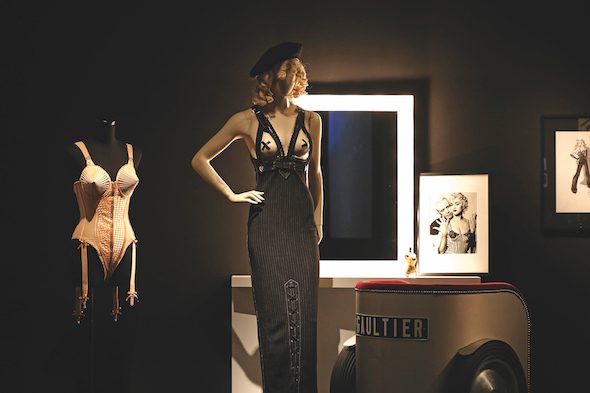
Installation view ‘Jean Paul Gaultier. From the Sidewalk to the Catwalk’ at the Kunsthalle München, 2015 // © Kunsthalle München
After having seen the impressive exhibition, curated by Thierry-Maxime Loriot, the answer must be even clearer than before: a radical No! It is essential to advocate for our freedom, for embodied passion, and express it without any misunderstood timidity. Gaultier shows with his Fashion-Art how the individual humans can make of their own bodies a canvas or exhibition. There mustn’t be any dress code whatsoever, unless maybe that of creativity and individual style. This is also, and even particularly the case, if one wants to put him or herself forward as a sex object, because one wants to seduce, because one has Eros!
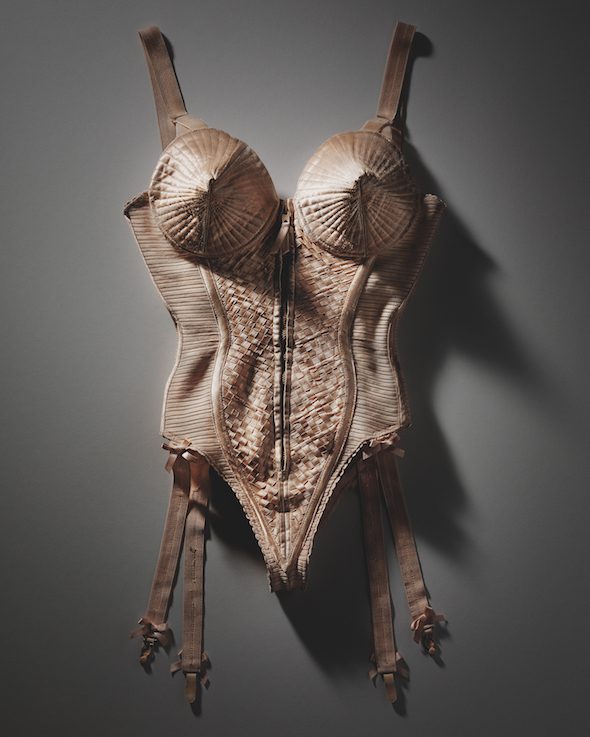
Emil Larsson: Madonna, 2008, Corset worn by Madonna, ‘Blond Ambition World Tour’, 1990 // © Emil Larsson
This credo’s famous climax rings true in the fashionable design of Madonna’s Blond Ambition World Tour back in 1990, designed by Jean Paul Gaultier. It was then that his (i)conical bras, his provocative corsets and his men’s skirts reached a broad public. But there was also a lot of exposed skin. Skin, combined with Gaultier’s designs, becomes a material means of expression. I remember very well the scandal, when Madonna stepped on to the catwalk in her famous black dress, presenting her naked breasts, designed by Gaultier. A new image of woman was born.
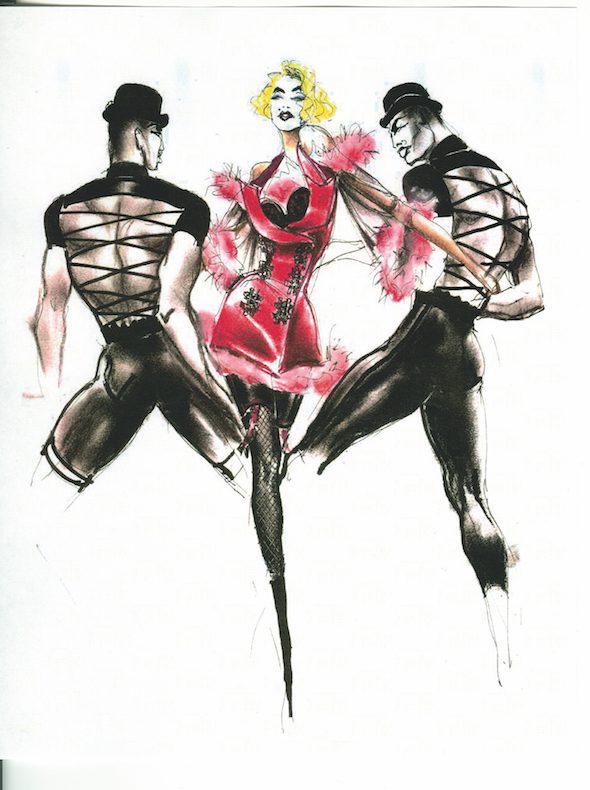
Thierry Perez for Jean Paul Gaultier, Sketch of a stage costume for Madonna, ‘Blond Ambition World Tour’, Material Girl segment, 1989–1990 // © Jean Paul Gaultier
Gaultier is a creator of sexual dreams, of sexual drama and accessories. In the Munich exhibition this comes to the fore particularly in the room “A fleur de peau”. There, one can find Gaultier’s erotic fashion. It is there, where he’s openly playing with the mask, the costume, the ambiguity of identities. Masculine and feminine symbols merge into a single aesthetic expression. He takes the stylistic devices of a profane sexshop on to the stage of Haute Couture. Everything is a layer of skin. I think of Paul Valery and his famous idea: “what is most deep is the skin.” The body with all its passion and lust serves the inspiration of aesthetic processing. Everything can be a fetish and/or the door to a magical world.
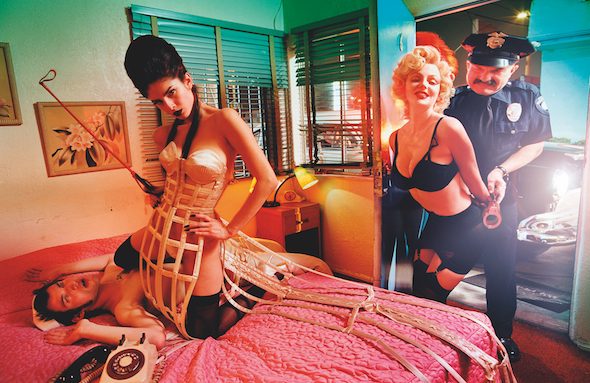
Hollywood Confidential, 1998, i-D, September 2002, Women’s prêt-à-porter, spring/summer 1989 // © David LaChapelle, with the kind permission of Fred Torres Collaborations
Gaultier’s women don’t need men to degrade them as a sex object. They take care of this self-consciously by themselves, only to reinvent themselves a moment later. In a highly expressive fashion they parade in turn men as mangy objects – men, who change their traditional roles by choice and wear skirts and men’s corsages. The famous couturier tailors corsages, with the help of which men and women are able to transform and change their self-image and can feel equipped with a seductive power. This is real freedom, the possibility of which consists less in the expression of a single costume, but more in the thematization and visualization of traditional roles, which comes into the viewer’s consciousness by being changed and exchanged, by losing their proposed implicitness.
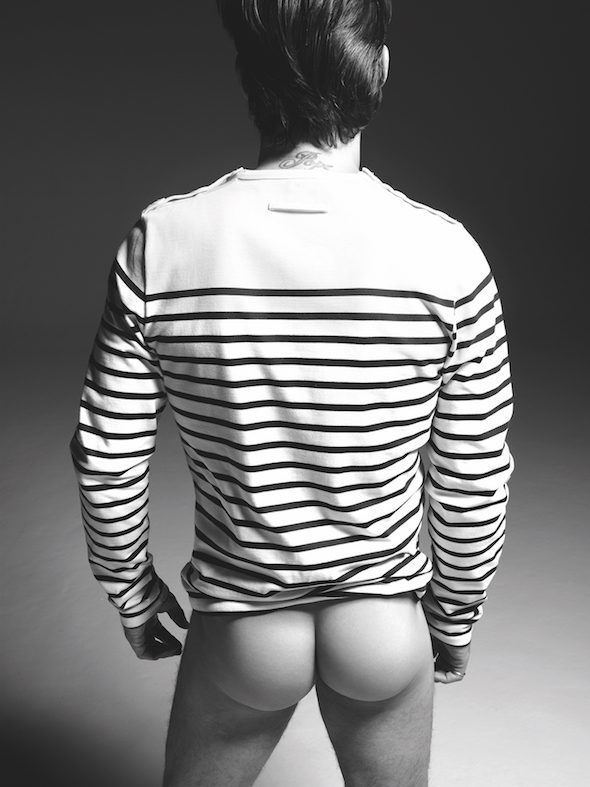
Levi Muntané: Tony, Mode d’emploi (Tony Ward), 2012 // © Xevi Muntané
In the exhibition’s first room, ‘the Salon’, Gaultier’s desire to break with old patterns, established traditions, hierarchies and over-styled aesthetics is visible at first sight. The corsage, so far often judged as discriminatory, is changed into a manifesto for the ‘New Woman’ (as well as for the ‘New Man’). It is here that it becomes a symbol for a new (feminine) self-consciousness. Women don’t wear it anymore under their clothes, as a constriction, but over their dresses, visible to everyone. Gaultier’s creation makes active changes in the image of femininity – a (wo)man is able to move differently, act seductively. The question, whether the active ‘taking over’ of sexism can be a possible answer to the explosive questions feminism is dealing with at the moment, remains hanging in the air as an assumption and subject of debate.
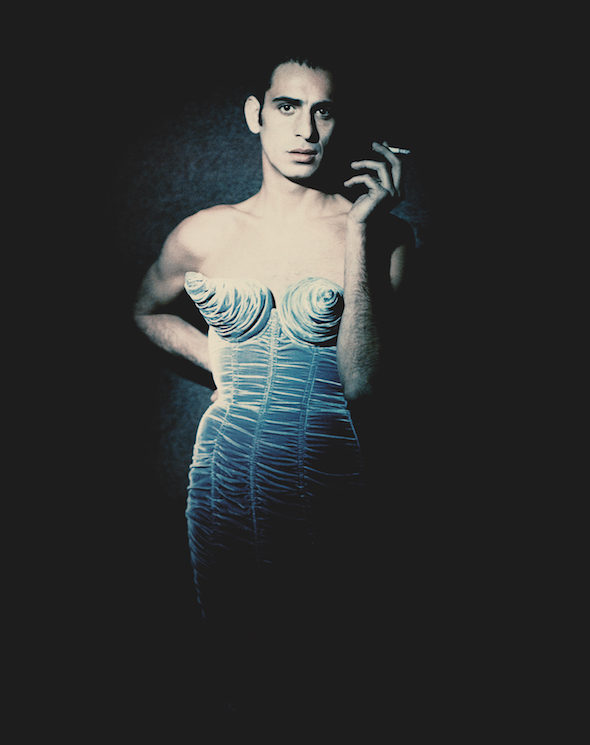
Paolo Roversi: Tanel Bedrossiantz, 1992, Barbès collection, Women’s prêt-à-porter fall/winter 1984–1985 // © Paolo Roversi
The corsage is combined with gigantic, protruding conic bras. The previous motif of the cage and being caged gets refracted, as the corsage leaves free spaces for skin to breathe: for example, in the display “Käfig-Korsettkleid aus Satin mit Kathedral-Schleppe.” (Satin cage corset dress with tulle skirt). Also in the choice of his materials, Gaultier doesn’t have any limits. His adventurous joy is visible again in the idea to manufacture a corset of wheat ears. In the ‘Urban Jungle’ room it becomes clear how all-encompassing his joy in combining exotic materials really is. In the merging of urban and barbaric stylistic devices he combines leather, velvet, bright enamel with crocodile’s skin, snakeskin, fur and feathers. His ‘Parrot-feather Bolero’ and ‘Crepe Jumpsuit’ complete the picture.
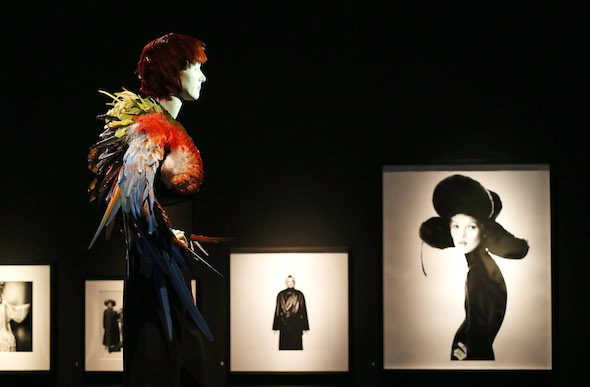
Installation view ‘Jean Paul Gaultier. From the Sidewalk to the Catwalk’ at the Kunsthalle München, 2015 // © Kunsthalle München
Gaultier concludes his stylistic argument with an irreconcilable dialectic, without taking sides for or against. There is, rather, the tendency to unify different elements in his very own style. Opposites are rubbing against each other seductively. This is celebrated in each room in a different way. In ‘Odyssee’, virgin Madonnas meet lascivious mermaids and sexualized nymphs and sirens. The sailors with their striped pullovers – Gaultier describes them (the stripes) as his personal fetish – behave like young princes. The room ‘Punk Cancean’ unifies elements of the French Belle Époque with the “raw” oddity of British culture between Tradition and Punk: the Dandy as a Punk, the Punk as a French Flaneur, the famous Moulin Rouge as a British Pub. Thus, Gaultier’s muses are always atypical models, as for example the opulent Beth Dito (in the room ‘Les muses’).
The embracing arrangement of living environments is also beautifully exposed in the presentations of Gaultier’s movie designs, like Luke Besson‘s The Fifth Element (1997) or Jean Pierre Jeunet‘s La cité des infants perdus (1995).
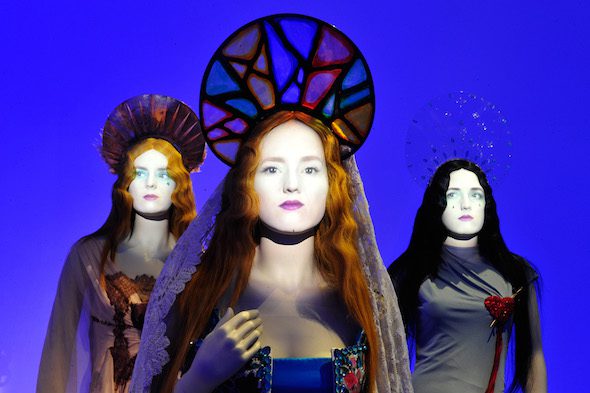
Installation view ‘Jean Paul Gaultier. From the Sidewalk to the Catwalk’ at the Kunsthalle München, 2015 // © Kunsthalle München
All in all, Jean Paul Gaultier’s work is a sublime mise-en-scene of variety, diversity, norm-breaking individuality, but also the anonymization of the latter by a mask. The mannequins have movie projections of living people in their faces. They begin to live, and people, in turn, begin to think about themselves as objects – a skillful game of changing identities. Each visitor is invited to join in, if he dares to step out of the narrowness of his own habits. A visit to the Gaultier exhibition is a suitable first step in this direction – it is open until February 14th at Kunsthalle München.
Exhibition
Kunsthalle München
Jean Paul Gaultier. From the Sidewalk to the Catwalk
Exhibition: Sep. 18, 2015 – Feb. 14, 2016
Open daily 10am to 8pm
Theatinerstrasse 8, 80333 München, click here for map
Writer Info
Julian Bachmann has a Master (Magister) in Philosophy, (with) focus on art theory and “social utopias” (LMU-Munich University). Julian is an editor and writer, based in Munich. For now he takes part in the project “LITO”, a collaboration between designers, filmmakers and writers.





















